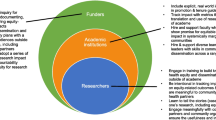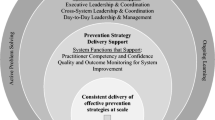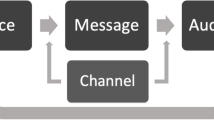Abstract
The importance of basing public policy on sound scientific evidence is increasingly being recognized, yet many barriers continue to slow the translation of prevention research into legislative action. This work reports on the feasibility of a model for overcoming these barriers—known as the Research-to-Policy Collaboration (RPC). The RPC employs strategic legislative needs assessments and a rapid response researcher network to accelerate the translation of research findings into usable knowledge for policymakers. Evaluation findings revealed that this model can successfully mobilize prevention scientists, engage legislative offices, connect policymakers and experts in prevention, and elicit congressional requests for evidence on effective prevention strategies. On average, the RPC model costs $3510 to implement per legislative office. The RPC can elicit requests for evidence at an average cost of $444 per request. The implications of this work, opportunities for optimizing project elements, and plans for future work are discussed. Ultimately, this project signals that the use of scientific knowledge of prevention in policymaking can be greatly augmented through strategic investment in translational efforts.


Similar content being viewed by others
References
Aarons, G. A., Hurlburt, M., & Horwitz, S. M. (2011). Advancing a conceptual model of evidence-based practice implementation in public service sectors. Administration and Policy in Mental Health and Mental Health Services Research, 38, 4–23.
Andrews, D. A., & Bonta, J. (2010). Rehabilitating criminal justice policy and practice. Psychology, Public Policy, and Law, 16, 39–55. doi:10.1037/a0018362.
Aos, S., Miller, M., & Drake, E. (2006). Evidence-based public policy options to reduce future prison construction, criminal justice costs, and crime rates (no. document no. 06–10-1201). Olympia, WA: Washington State Institute for Public Policy.
Association for Public Policy and Management. (2015). APPAM 2015 fall research conference: the golden age of evidence-based policy. Retrieved from http://www.appam.org/events/fall-research-conference/2015-fall-research-conference-information/.
Baron, J., & Haskins, R. (2011). The Obama Administration’s evidence-based social policy initiatives: an overview. Retrieved from http://www.brookings.edu/opinions/2011/1102
Beck, C., Gately, K. J., Lubin, S., Moody, P., & Beverly, C. (2014). Building a state coalition for nursing home excellence. The Gerontologist, 54, S87–S97.
Ben-Arieh, D., & Qian, L. (2003). Activity-based cost management for design and development stage. International Journal of Production Economics, 83, 169–183.
Biglan, A. (2016). The ultimate goal of prevention and the larger context for translation. Prevention Science. doi:10.1007/s11121-016-0635-6.
Bowen, S., & Zwi, A. B. (2005). Pathways to “evidence-informed” policy and practice: a framework for action. PLoS Medicine, 2, e166.
Brouwer, W. B. F., Koopmanschap, M. A., & Rutten, F. F. H. (1997). Productivity costs in cost-effectiveness analysis. Health Economics, 6, 511–514.
Brown, D., Feinberg, M. E., & Greenberg, M. T. (2010). Determinants of community coalition ability to support evidence-based programs. Prevention Science, 11, 287–297.
Brownson, R. C., Haire-Joshu, D., & Luke, D. A. (2006). Shaping the context of health: a review of environmental and policy approaches in the prevention of chronic diseases. Annual Review of Public Health, 27, 341–370. doi:10.1146/annurev.
Choi, B. C. K. (2005). Can scientists and policy makers work together? Journal of Epidemiology & Community Health, 59, 632–637. doi:10.1136/jech.2004.031765.
Crowley, D. M. (2013). Building efficient crime prevention strategies considering the economics of investing in human development. Criminology & Public Policy, 12, 353–366.
Crowley, D., Jones, D. E., Coffman, D. L., & Greenberg, M. T. (2014). Can we build an efficient response to the prescription drug abuse epidemic? Preventive Medicine, 62, 71–77.
Crowley, D. M., Jones, D. E., Greenberg, M. T., Feinberg, M. E., & Spoth, R. (2012). Resource consumption of a diffusion model for prevention programs: the PROSPER delivery system. Journal of Adolescent Health, 50, 256–263.
Crowley, M., & Jones, D. (2015). Financing prevention: Opportunities for economic analysis across the translational research cycle. Translational Behavioral Medicine, 6, 145–152.
Cummings, W. K., & Williams, J. H. (2008). Policy-making for education reform in developing countries. Lanham: Rowman & Littlefield Education.
Dobbins, M., Robeson, P., Ciliska, D., Hanna, S., Cameron, R., O’Mara, L., et al. (2009). A description of a knowledge broker role implemented as part of a randomized controlled trial evaluating three knowledge translation strategies. Implementation Science, 4, 1–9. doi:10.1186/1748-5908-4-23.
Fishbein, D. H., Ridenour, T. A., Stahl, M., & Sussman, S. (2016). The full translational spectrum of prevention science. Translational Behavioral Medicine, 6, 5–16.
Flay, B. R., Biglan, A., Boruch, R. F., Castro, F. G., Gottfredson, D., Kellam, S., et al. (2005). Standards of evidence: Criteria for efficacy, effectiveness and dissemination. Prevention Science, 6, 151–175. doi:10.1007/s11121-005-5553-y.
Foa, E. B., Gillihan, S. J., & Bryant, R. A. (2013). Challenges and successes in dissemination of evidence-based treatments for posttraumatic stress: Lessons learned from prolonged exposure therapy for PTSD. Psychological Science in the Public Interest, 14, 65–111.
Fox, D. M. (2005). Evidence of evidence-based health policy: the politics of systematic reviews in coverage decisions. Health Affairs, 24, 114–122.
Ginexi, E. M. (2006). What’s next for translation research? Evaluation & the Health Professions, 29, 334–347. doi:10.1177/0163278706290409.
Gottfredson, D. C., Cook, T. D., Gardner, F. E. M., Gorman-Smith, D., Howe, G. W., Sandler, I. N., & Zafft, K. M. (2015). Standards of evidence for efficacy, effectiveness, and scale-up research in prevention science: Next generation. Prevention Science, 16, 893–926.
Hans, E. W., van Houdenhoven, M., & Hulshof, P. J. H. (2012). A framework for healthcare planning and control. In R. Hall (Ed.), Handbook of healthcare system scheduling. Springer US: Boston, MA. doi:10.1007/978-1-.
Haskins, R., & Margolis, G. (2015). Show me the evidence: Obama’s fight for rigor and evidence in social policy. Washington, DC: Brookings Institution Press.
Hoffmann, C., Stoykova, B. A., Nixon, J., Glanville, J. M., Misso, K., & Drummond, M. F. (2002). Do health-care decision makers find economic evaluations useful? The findings of focus group research in UK health authorities. Value in Health, 5, 71–78.
Khangura, S., Konnyu, K., Cushman, R., Grimshaw, J., & Moher, D. (2012). Evidence summaries: the evolution of a rapid review approach. Systematic Reviews, 1, 1–9.
Kingdon, J. W. (1984). Agendas, alternatives, and public policies. Boston, MA: Little, Brown.
Levin, & McEwan. (2000). Cost-effectiveness analysis: Methods and applications. Thousand Oaks, CA: Sage Publications.
Mason, E., & Shelton, J. (2016). Facts over factions. Stanford Social Innovation Review. Retrieved from https://ssir.org/articles/entry/facts
Meyer, M. (2010). The rise of the knowledge broker. Science Communication, 32, 118–127.
Milner, J. (2016). Everything you need to know about the Commission on Evidence-Based Policymaking. Retrieved from http://www.urban.org/urban-wire/everything-you-need-know-about-commission-evidence-based-policymaking
National Academies of Sciences, Engineering, and Medicine. (2016). Advancing the power of economic evidence to inform investments in children, youth, and families. Washington DC: The National Academies Press.
National Research Council. (2012). Using science as evidence in public policy. Washington DC: The National Academies Press.
O’Connell, M. E., Boat, T. F., & Warner, K. E. (2009). Preventing mental, emotional, and behavioral disorders among young people: Progress and possibilities. Washington, D.C.: National Academies Press.
Oliver, K., Innvar, S., Lorenc, T., Woodman, J., & Thomas, J. (2014a). A systematic review of barriers to and facilitators of the use of evidence by policymakers. BMC Health Services Research, 14, 1–12.
Oliver, K., Lorenc, T., & Innvær, S. (2014b). New directions in evidence-based policy research: a critical analysis of the literature. Health Research Policy and Systems, 12, 1–11.
Smith, R. D. (2013). Strategic planning for public relations (4th ed.). New York, NY: Routledge, Taylor & Francis Group.
Tseng, V. (2012). The uses of research in policy and practice. Social policy report. Ann Arbor, MI: Society for Research in Child Development.
Vandlandingham, G., & Silloway, T. (2015). Bridging the gap between evidence and policymakers: a case study for the Pew-MacArthur results first initiative. Public Administration Review, 76, 542–546. doi:10.1111/puar.12603.
Acknowledgements
This work was funded through a grant from the Doris Duke Charitable Foundation, Prevention Economics Planning and Research Network, National Institute on Drug Abuse (R13 DA036339) and support from the Penn State University Social Science Research Institute and Bennett Pierce Prevention Research Center. We gratefully acknowledge the contributions of the prevention scientists and legislative offices that took part in this pilot work. Further, this work was supported by institutional resources from the National Coalition for Prevention Science and Prevention Economics Planning and Research Network. Sponsorship for the implementation of the RPC model also came from the Society for Prevention Science, Society for Community Research and Action, Society for Child and Family Policy and Practice, Child Trends, The American Orthopsychiatric Association, and Paxis. Individuals supporting the RPC model include Neil Wollman, Robin Jenkins, and Bobby Vassar. Additionally, we gratefully acknowledge the participation of the different legislative offices and prevention experts.
Funding
This work was supported through a grant from the Doris Duke Charitable Foundation, Prevention Economics Planning and Research Network, National Institute on Drug Abuse (R13 DA036339), and support from the Penn State University Social Science Research Institute and Bennett Pierce Prevention Research Center.
Author information
Authors and Affiliations
Corresponding author
Ethics declarations
Conflict of Interest
The authors declare that they have no conflict of interest.
Ethical Approval
Not applicable
Informed Consent
Not applicable
Rights and permissions
About this article
Cite this article
Crowley, M., Scott, J.B. & Fishbein, D. Translating Prevention Research for Evidence-Based Policymaking: Results from the Research-to-Policy Collaboration Pilot. Prev Sci 19, 260–270 (2018). https://doi.org/10.1007/s11121-017-0833-x
Published:
Issue Date:
DOI: https://doi.org/10.1007/s11121-017-0833-x




